BCO5501: Business Process Management and Digital Innovation Research
VerifiedAdded on 2022/12/19
|19
|5037
|84
Report
AI Summary
This report delves into the crucial relationship between Business Process Management (BPM) and digital innovation, examining how digital technologies are transforming businesses. It explores the impact of digitalization on various aspects of business, including innovation, entrepreneurship, and operational processes. The report discusses different perspectives on BPM and digitalization, highlighting the importance of integrating technology to enhance efficiency, agility, and competitiveness. It provides arguments supporting the purpose of linking BPM with digital innovation and presents relevant case studies to illustrate the concepts. The research covers topics such as digital transformation, IT investment strategies, the role of data, and the success factors for implementing BPM in a digital context. Ultimately, the report aims to provide a comprehensive understanding of how businesses can leverage BPM and digital innovation to achieve strategic goals and adapt to the evolving market landscape. It is based on research from the 14th-16th International Conference on Business Process Management (BPM).
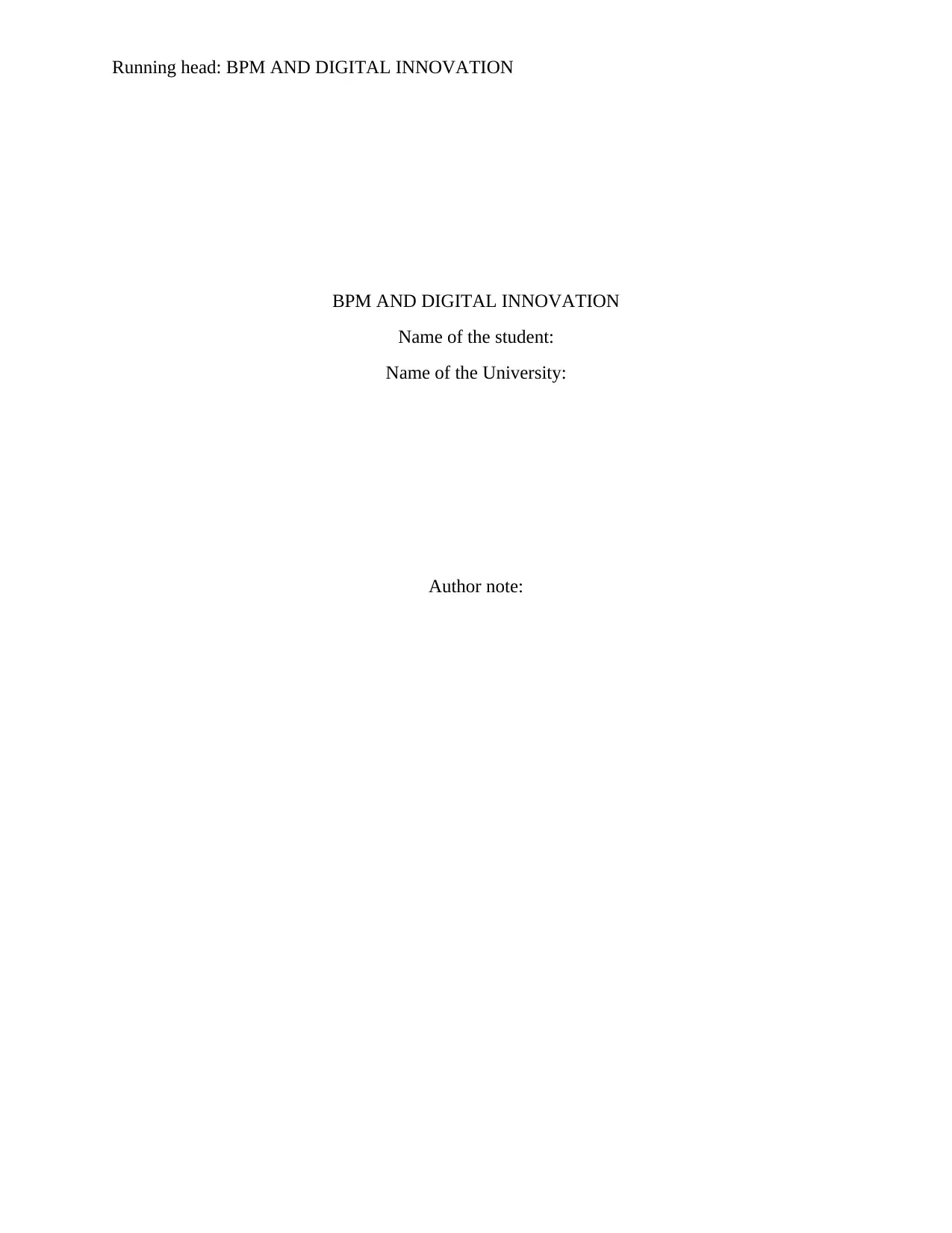
Running head: BPM AND DIGITAL INNOVATION
BPM AND DIGITAL INNOVATION
Name of the student:
Name of the University:
Author note:
BPM AND DIGITAL INNOVATION
Name of the student:
Name of the University:
Author note:
Paraphrase This Document
Need a fresh take? Get an instant paraphrase of this document with our AI Paraphraser

BPM AND DIGITAL INNOVATION
Table of Contents
Introduction......................................................................................................................................2
Business process Management and digitalization:..........................................................................3
Different perspectives of BPM and Digitalization:.........................................................................5
Arguments supporting the purpose of the report:............................................................................8
Case studies:..................................................................................................................................10
Conclusion.....................................................................................................................................12
References......................................................................................................................................14
N a m e : S t u d e n t I D : P a g e 1 | 19
Table of Contents
Introduction......................................................................................................................................2
Business process Management and digitalization:..........................................................................3
Different perspectives of BPM and Digitalization:.........................................................................5
Arguments supporting the purpose of the report:............................................................................8
Case studies:..................................................................................................................................10
Conclusion.....................................................................................................................................12
References......................................................................................................................................14
N a m e : S t u d e n t I D : P a g e 1 | 19
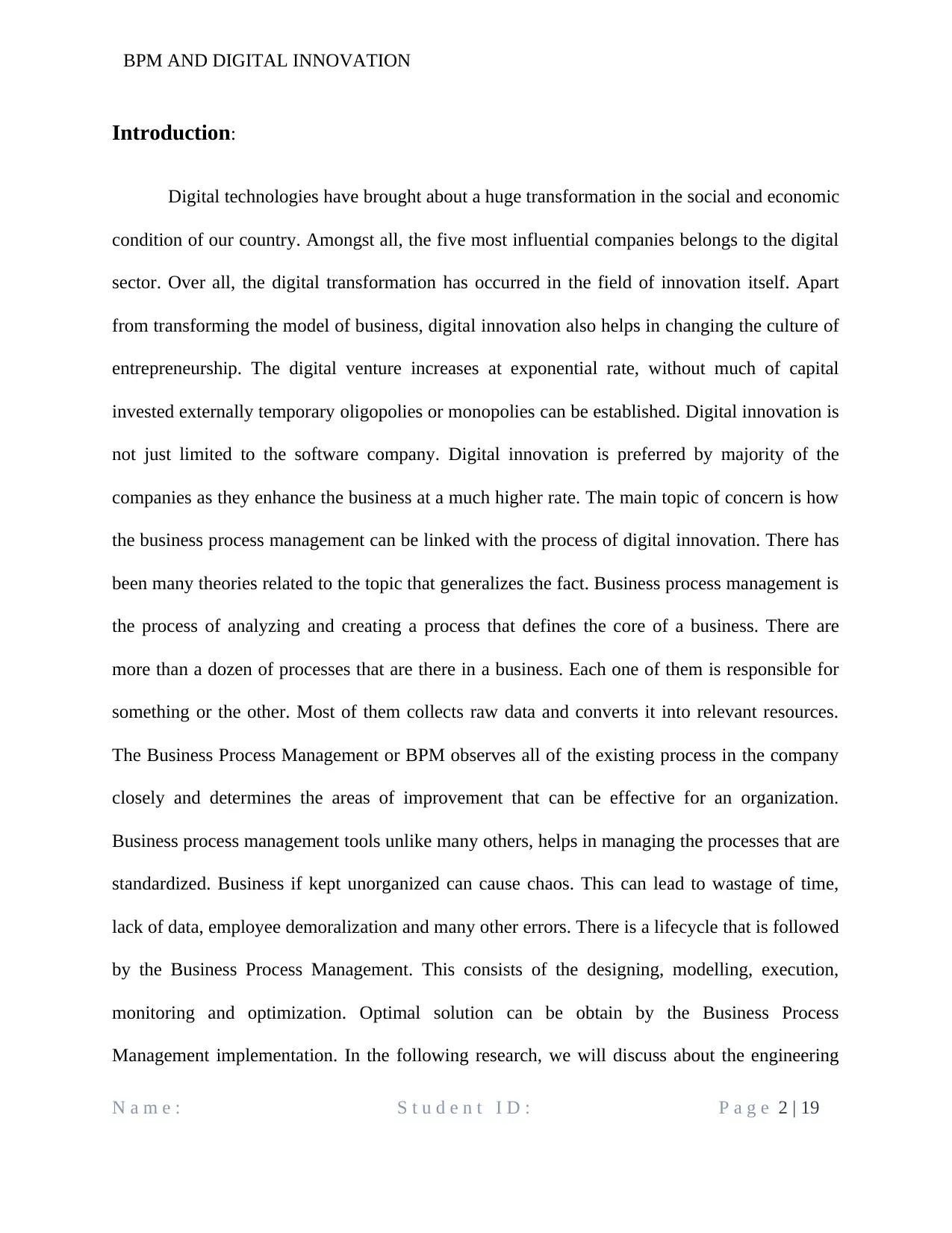
BPM AND DIGITAL INNOVATION
Introduction:
Digital technologies have brought about a huge transformation in the social and economic
condition of our country. Amongst all, the five most influential companies belongs to the digital
sector. Over all, the digital transformation has occurred in the field of innovation itself. Apart
from transforming the model of business, digital innovation also helps in changing the culture of
entrepreneurship. The digital venture increases at exponential rate, without much of capital
invested externally temporary oligopolies or monopolies can be established. Digital innovation is
not just limited to the software company. Digital innovation is preferred by majority of the
companies as they enhance the business at a much higher rate. The main topic of concern is how
the business process management can be linked with the process of digital innovation. There has
been many theories related to the topic that generalizes the fact. Business process management is
the process of analyzing and creating a process that defines the core of a business. There are
more than a dozen of processes that are there in a business. Each one of them is responsible for
something or the other. Most of them collects raw data and converts it into relevant resources.
The Business Process Management or BPM observes all of the existing process in the company
closely and determines the areas of improvement that can be effective for an organization.
Business process management tools unlike many others, helps in managing the processes that are
standardized. Business if kept unorganized can cause chaos. This can lead to wastage of time,
lack of data, employee demoralization and many other errors. There is a lifecycle that is followed
by the Business Process Management. This consists of the designing, modelling, execution,
monitoring and optimization. Optimal solution can be obtain by the Business Process
Management implementation. In the following research, we will discuss about the engineering
N a m e : S t u d e n t I D : P a g e 2 | 19
Introduction:
Digital technologies have brought about a huge transformation in the social and economic
condition of our country. Amongst all, the five most influential companies belongs to the digital
sector. Over all, the digital transformation has occurred in the field of innovation itself. Apart
from transforming the model of business, digital innovation also helps in changing the culture of
entrepreneurship. The digital venture increases at exponential rate, without much of capital
invested externally temporary oligopolies or monopolies can be established. Digital innovation is
not just limited to the software company. Digital innovation is preferred by majority of the
companies as they enhance the business at a much higher rate. The main topic of concern is how
the business process management can be linked with the process of digital innovation. There has
been many theories related to the topic that generalizes the fact. Business process management is
the process of analyzing and creating a process that defines the core of a business. There are
more than a dozen of processes that are there in a business. Each one of them is responsible for
something or the other. Most of them collects raw data and converts it into relevant resources.
The Business Process Management or BPM observes all of the existing process in the company
closely and determines the areas of improvement that can be effective for an organization.
Business process management tools unlike many others, helps in managing the processes that are
standardized. Business if kept unorganized can cause chaos. This can lead to wastage of time,
lack of data, employee demoralization and many other errors. There is a lifecycle that is followed
by the Business Process Management. This consists of the designing, modelling, execution,
monitoring and optimization. Optimal solution can be obtain by the Business Process
Management implementation. In the following research, we will discuss about the engineering
N a m e : S t u d e n t I D : P a g e 2 | 19
⊘ This is a preview!⊘
Do you want full access?
Subscribe today to unlock all pages.

Trusted by 1+ million students worldwide
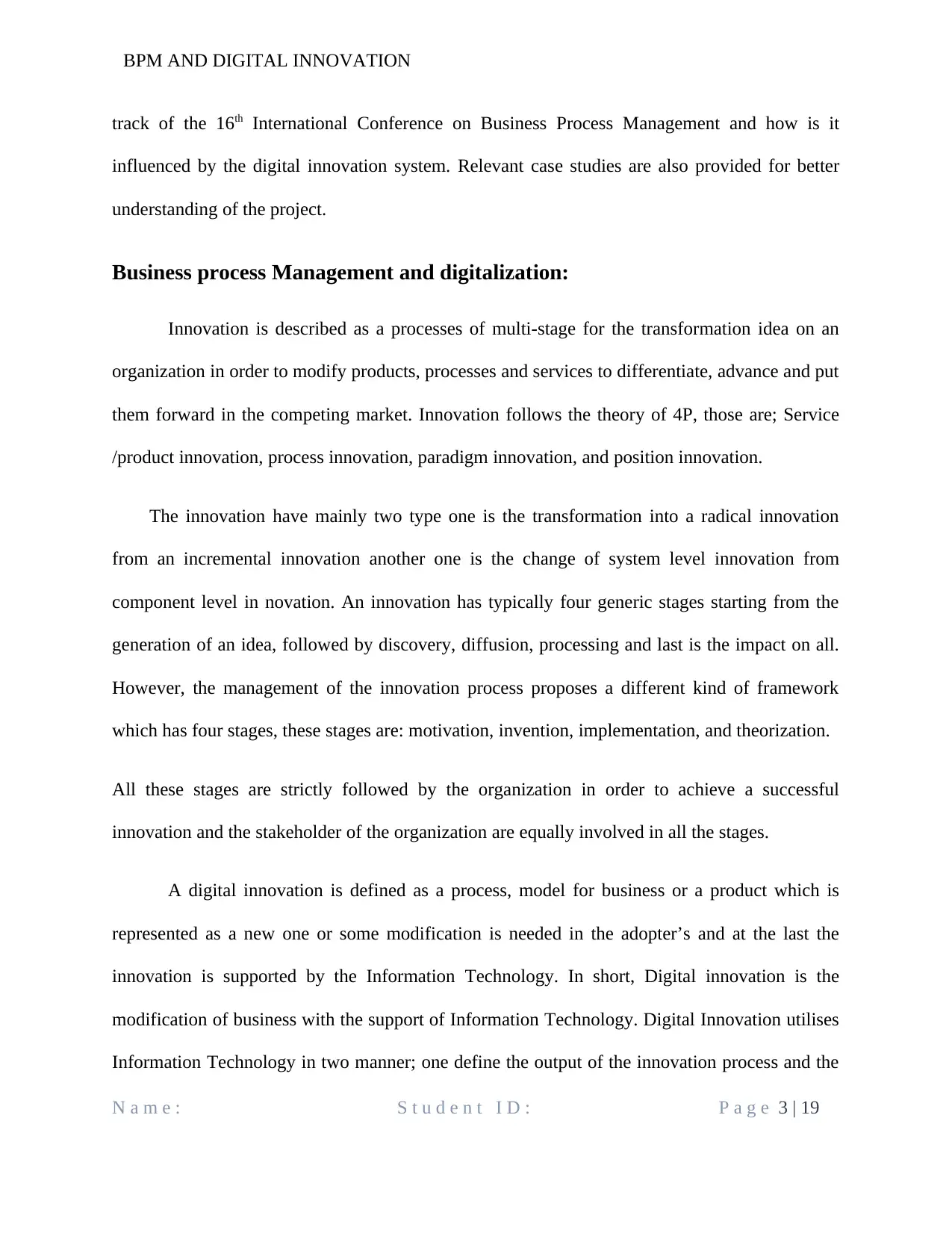
BPM AND DIGITAL INNOVATION
track of the 16th International Conference on Business Process Management and how is it
influenced by the digital innovation system. Relevant case studies are also provided for better
understanding of the project.
Business process Management and digitalization:
Innovation is described as a processes of multi-stage for the transformation idea on an
organization in order to modify products, processes and services to differentiate, advance and put
them forward in the competing market. Innovation follows the theory of 4P, those are; Service
/product innovation, process innovation, paradigm innovation, and position innovation.
The innovation have mainly two type one is the transformation into a radical innovation
from an incremental innovation another one is the change of system level innovation from
component level in novation. An innovation has typically four generic stages starting from the
generation of an idea, followed by discovery, diffusion, processing and last is the impact on all.
However, the management of the innovation process proposes a different kind of framework
which has four stages, these stages are: motivation, invention, implementation, and theorization.
All these stages are strictly followed by the organization in order to achieve a successful
innovation and the stakeholder of the organization are equally involved in all the stages.
A digital innovation is defined as a process, model for business or a product which is
represented as a new one or some modification is needed in the adopter’s and at the last the
innovation is supported by the Information Technology. In short, Digital innovation is the
modification of business with the support of Information Technology. Digital Innovation utilises
Information Technology in two manner; one define the output of the innovation process and the
N a m e : S t u d e n t I D : P a g e 3 | 19
track of the 16th International Conference on Business Process Management and how is it
influenced by the digital innovation system. Relevant case studies are also provided for better
understanding of the project.
Business process Management and digitalization:
Innovation is described as a processes of multi-stage for the transformation idea on an
organization in order to modify products, processes and services to differentiate, advance and put
them forward in the competing market. Innovation follows the theory of 4P, those are; Service
/product innovation, process innovation, paradigm innovation, and position innovation.
The innovation have mainly two type one is the transformation into a radical innovation
from an incremental innovation another one is the change of system level innovation from
component level in novation. An innovation has typically four generic stages starting from the
generation of an idea, followed by discovery, diffusion, processing and last is the impact on all.
However, the management of the innovation process proposes a different kind of framework
which has four stages, these stages are: motivation, invention, implementation, and theorization.
All these stages are strictly followed by the organization in order to achieve a successful
innovation and the stakeholder of the organization are equally involved in all the stages.
A digital innovation is defined as a process, model for business or a product which is
represented as a new one or some modification is needed in the adopter’s and at the last the
innovation is supported by the Information Technology. In short, Digital innovation is the
modification of business with the support of Information Technology. Digital Innovation utilises
Information Technology in two manner; one define the output of the innovation process and the
N a m e : S t u d e n t I D : P a g e 3 | 19
Paraphrase This Document
Need a fresh take? Get an instant paraphrase of this document with our AI Paraphraser
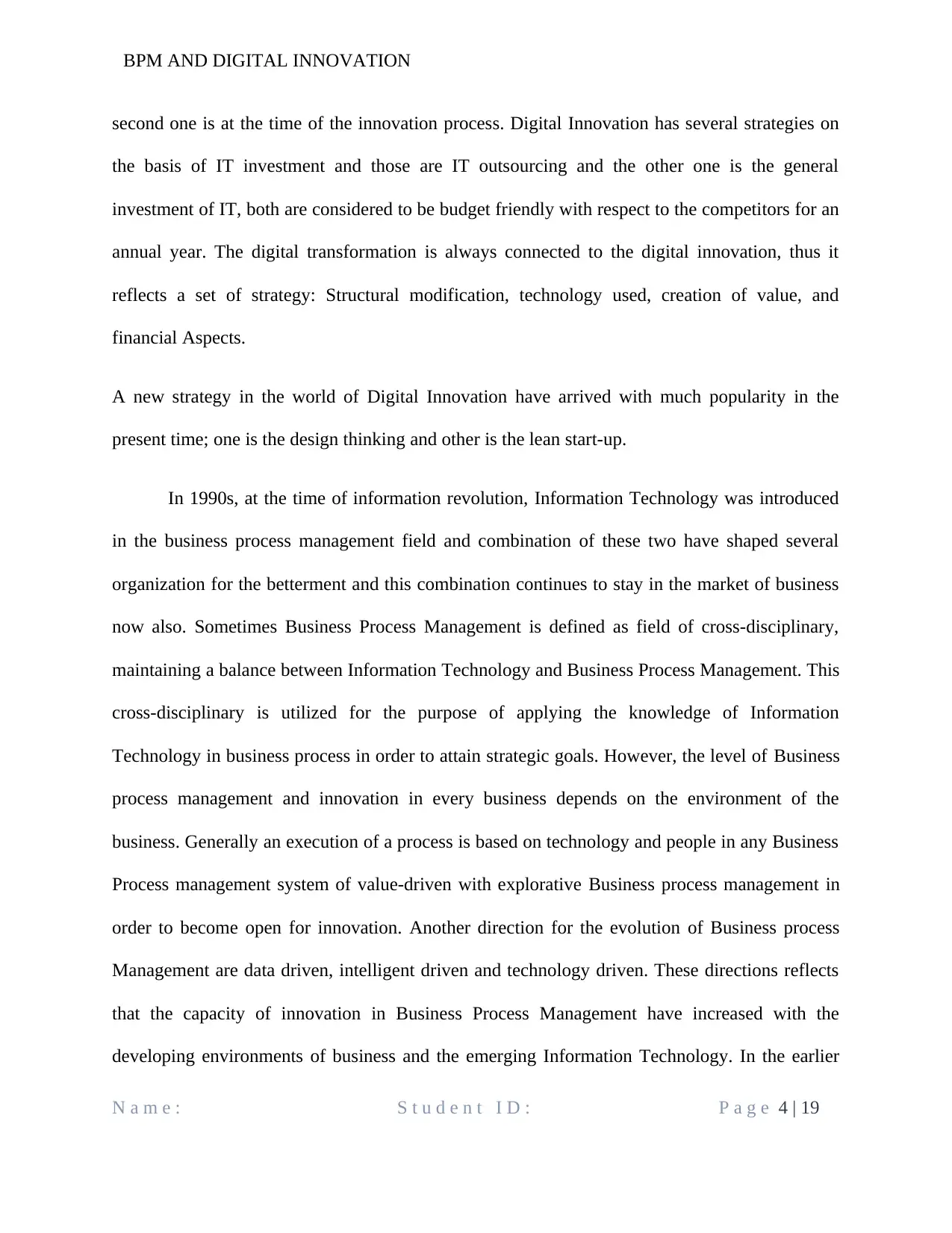
BPM AND DIGITAL INNOVATION
second one is at the time of the innovation process. Digital Innovation has several strategies on
the basis of IT investment and those are IT outsourcing and the other one is the general
investment of IT, both are considered to be budget friendly with respect to the competitors for an
annual year. The digital transformation is always connected to the digital innovation, thus it
reflects a set of strategy: Structural modification, technology used, creation of value, and
financial Aspects.
A new strategy in the world of Digital Innovation have arrived with much popularity in the
present time; one is the design thinking and other is the lean start-up.
In 1990s, at the time of information revolution, Information Technology was introduced
in the business process management field and combination of these two have shaped several
organization for the betterment and this combination continues to stay in the market of business
now also. Sometimes Business Process Management is defined as field of cross-disciplinary,
maintaining a balance between Information Technology and Business Process Management. This
cross-disciplinary is utilized for the purpose of applying the knowledge of Information
Technology in business process in order to attain strategic goals. However, the level of Business
process management and innovation in every business depends on the environment of the
business. Generally an execution of a process is based on technology and people in any Business
Process management system of value-driven with explorative Business process management in
order to become open for innovation. Another direction for the evolution of Business process
Management are data driven, intelligent driven and technology driven. These directions reflects
that the capacity of innovation in Business Process Management have increased with the
developing environments of business and the emerging Information Technology. In the earlier
N a m e : S t u d e n t I D : P a g e 4 | 19
second one is at the time of the innovation process. Digital Innovation has several strategies on
the basis of IT investment and those are IT outsourcing and the other one is the general
investment of IT, both are considered to be budget friendly with respect to the competitors for an
annual year. The digital transformation is always connected to the digital innovation, thus it
reflects a set of strategy: Structural modification, technology used, creation of value, and
financial Aspects.
A new strategy in the world of Digital Innovation have arrived with much popularity in the
present time; one is the design thinking and other is the lean start-up.
In 1990s, at the time of information revolution, Information Technology was introduced
in the business process management field and combination of these two have shaped several
organization for the betterment and this combination continues to stay in the market of business
now also. Sometimes Business Process Management is defined as field of cross-disciplinary,
maintaining a balance between Information Technology and Business Process Management. This
cross-disciplinary is utilized for the purpose of applying the knowledge of Information
Technology in business process in order to attain strategic goals. However, the level of Business
process management and innovation in every business depends on the environment of the
business. Generally an execution of a process is based on technology and people in any Business
Process management system of value-driven with explorative Business process management in
order to become open for innovation. Another direction for the evolution of Business process
Management are data driven, intelligent driven and technology driven. These directions reflects
that the capacity of innovation in Business Process Management have increased with the
developing environments of business and the emerging Information Technology. In the earlier
N a m e : S t u d e n t I D : P a g e 4 | 19

BPM AND DIGITAL INNOVATION
days Business Process Management mainly focused on the process of structured business but
with the introduction of Digital Innovation the focus of Business Process management has
statistically shifted towards the data rather than just the process related to structured business.
The success factors of the Business Process Management have several approaches such
as from the point of view of the occurring issue, roadmaps and model assessments, on the basis
of theories, and statistical formulas. The examples of the approaches are, at first the operational,
tactical and strategic issues for adoption by Business Process Management. Secondly, CMMI
which is a maturity model for the improvement of the capable areas. Thirdly, the discipline of
Business Process Management with the theories of dynamic capabilities, contingency and task-
technology fit. Fourthly, the mathematical approach in order to evaluate the implementation of
Business Process Management. Other supporting factors for the success can be; high
management support, collaborative surrounding, strategic alignment and efficient project
management. Hence, several success factors exist for the implementation of Business Process
management for interrupting Digital Innovation relevance.
Different perspectives of BPM and Digitalization:
According to F. Imgrund, M. Fischer, C. Janiesch, and A. Winkelmann, the
transformation of information into digital form have improved the processing of information in
business. In order to get benefited by these, business have increased the use of Information
technology and the implementation of the strategies of Information Technology. This process is
enhanced by accelerating the consistency and agility of business process by the implementation
of Information Technology. The process of digital transformation has extensively initiated for
the developing industries. These transformation have increased with the emerging technologies
N a m e : S t u d e n t I D : P a g e 5 | 19
days Business Process Management mainly focused on the process of structured business but
with the introduction of Digital Innovation the focus of Business Process management has
statistically shifted towards the data rather than just the process related to structured business.
The success factors of the Business Process Management have several approaches such
as from the point of view of the occurring issue, roadmaps and model assessments, on the basis
of theories, and statistical formulas. The examples of the approaches are, at first the operational,
tactical and strategic issues for adoption by Business Process Management. Secondly, CMMI
which is a maturity model for the improvement of the capable areas. Thirdly, the discipline of
Business Process Management with the theories of dynamic capabilities, contingency and task-
technology fit. Fourthly, the mathematical approach in order to evaluate the implementation of
Business Process Management. Other supporting factors for the success can be; high
management support, collaborative surrounding, strategic alignment and efficient project
management. Hence, several success factors exist for the implementation of Business Process
management for interrupting Digital Innovation relevance.
Different perspectives of BPM and Digitalization:
According to F. Imgrund, M. Fischer, C. Janiesch, and A. Winkelmann, the
transformation of information into digital form have improved the processing of information in
business. In order to get benefited by these, business have increased the use of Information
technology and the implementation of the strategies of Information Technology. This process is
enhanced by accelerating the consistency and agility of business process by the implementation
of Information Technology. The process of digital transformation has extensively initiated for
the developing industries. These transformation have increased with the emerging technologies
N a m e : S t u d e n t I D : P a g e 5 | 19
⊘ This is a preview!⊘
Do you want full access?
Subscribe today to unlock all pages.

Trusted by 1+ million students worldwide
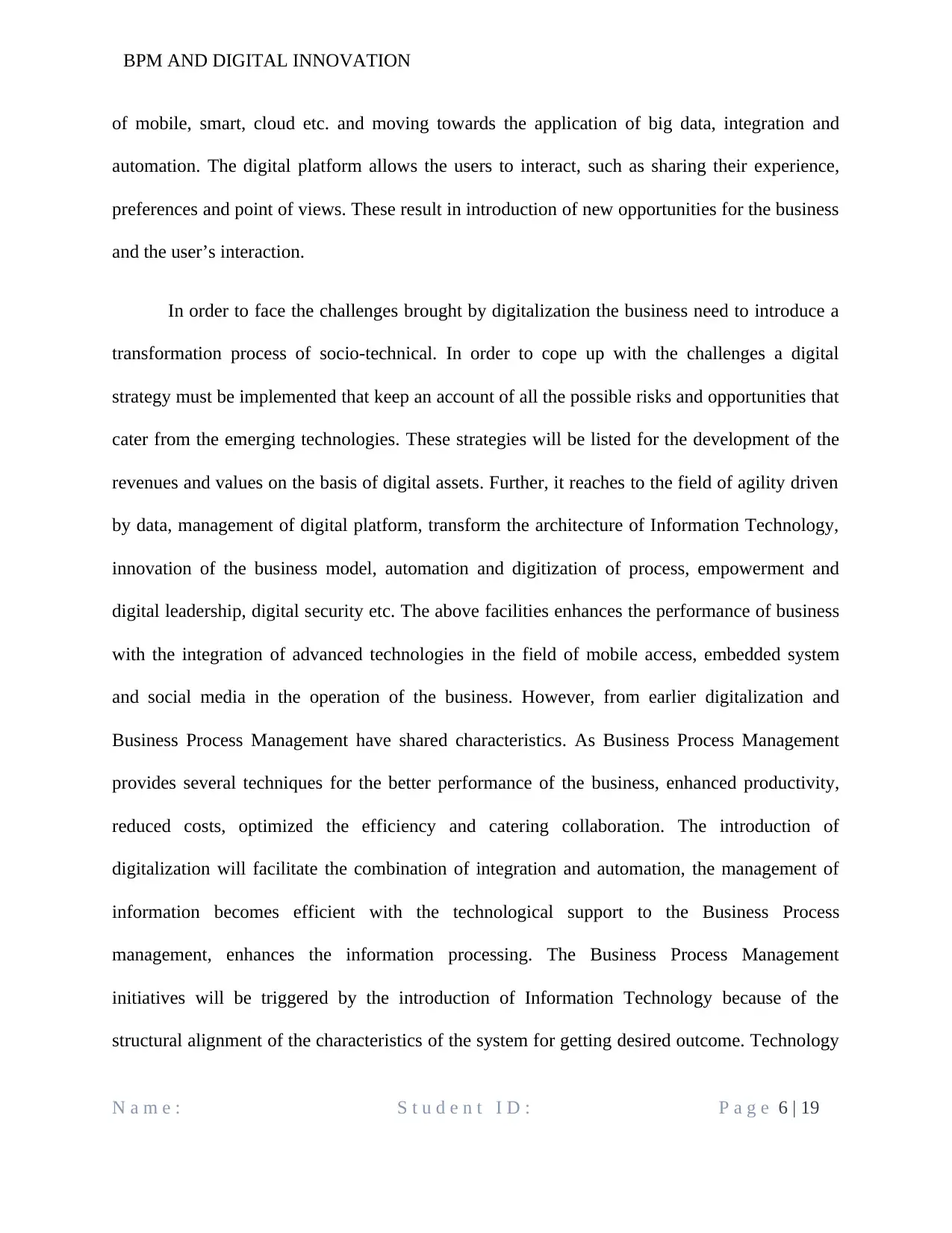
BPM AND DIGITAL INNOVATION
of mobile, smart, cloud etc. and moving towards the application of big data, integration and
automation. The digital platform allows the users to interact, such as sharing their experience,
preferences and point of views. These result in introduction of new opportunities for the business
and the user’s interaction.
In order to face the challenges brought by digitalization the business need to introduce a
transformation process of socio-technical. In order to cope up with the challenges a digital
strategy must be implemented that keep an account of all the possible risks and opportunities that
cater from the emerging technologies. These strategies will be listed for the development of the
revenues and values on the basis of digital assets. Further, it reaches to the field of agility driven
by data, management of digital platform, transform the architecture of Information Technology,
innovation of the business model, automation and digitization of process, empowerment and
digital leadership, digital security etc. The above facilities enhances the performance of business
with the integration of advanced technologies in the field of mobile access, embedded system
and social media in the operation of the business. However, from earlier digitalization and
Business Process Management have shared characteristics. As Business Process Management
provides several techniques for the better performance of the business, enhanced productivity,
reduced costs, optimized the efficiency and catering collaboration. The introduction of
digitalization will facilitate the combination of integration and automation, the management of
information becomes efficient with the technological support to the Business Process
management, enhances the information processing. The Business Process Management
initiatives will be triggered by the introduction of Information Technology because of the
structural alignment of the characteristics of the system for getting desired outcome. Technology
N a m e : S t u d e n t I D : P a g e 6 | 19
of mobile, smart, cloud etc. and moving towards the application of big data, integration and
automation. The digital platform allows the users to interact, such as sharing their experience,
preferences and point of views. These result in introduction of new opportunities for the business
and the user’s interaction.
In order to face the challenges brought by digitalization the business need to introduce a
transformation process of socio-technical. In order to cope up with the challenges a digital
strategy must be implemented that keep an account of all the possible risks and opportunities that
cater from the emerging technologies. These strategies will be listed for the development of the
revenues and values on the basis of digital assets. Further, it reaches to the field of agility driven
by data, management of digital platform, transform the architecture of Information Technology,
innovation of the business model, automation and digitization of process, empowerment and
digital leadership, digital security etc. The above facilities enhances the performance of business
with the integration of advanced technologies in the field of mobile access, embedded system
and social media in the operation of the business. However, from earlier digitalization and
Business Process Management have shared characteristics. As Business Process Management
provides several techniques for the better performance of the business, enhanced productivity,
reduced costs, optimized the efficiency and catering collaboration. The introduction of
digitalization will facilitate the combination of integration and automation, the management of
information becomes efficient with the technological support to the Business Process
management, enhances the information processing. The Business Process Management
initiatives will be triggered by the introduction of Information Technology because of the
structural alignment of the characteristics of the system for getting desired outcome. Technology
N a m e : S t u d e n t I D : P a g e 6 | 19
Paraphrase This Document
Need a fresh take? Get an instant paraphrase of this document with our AI Paraphraser
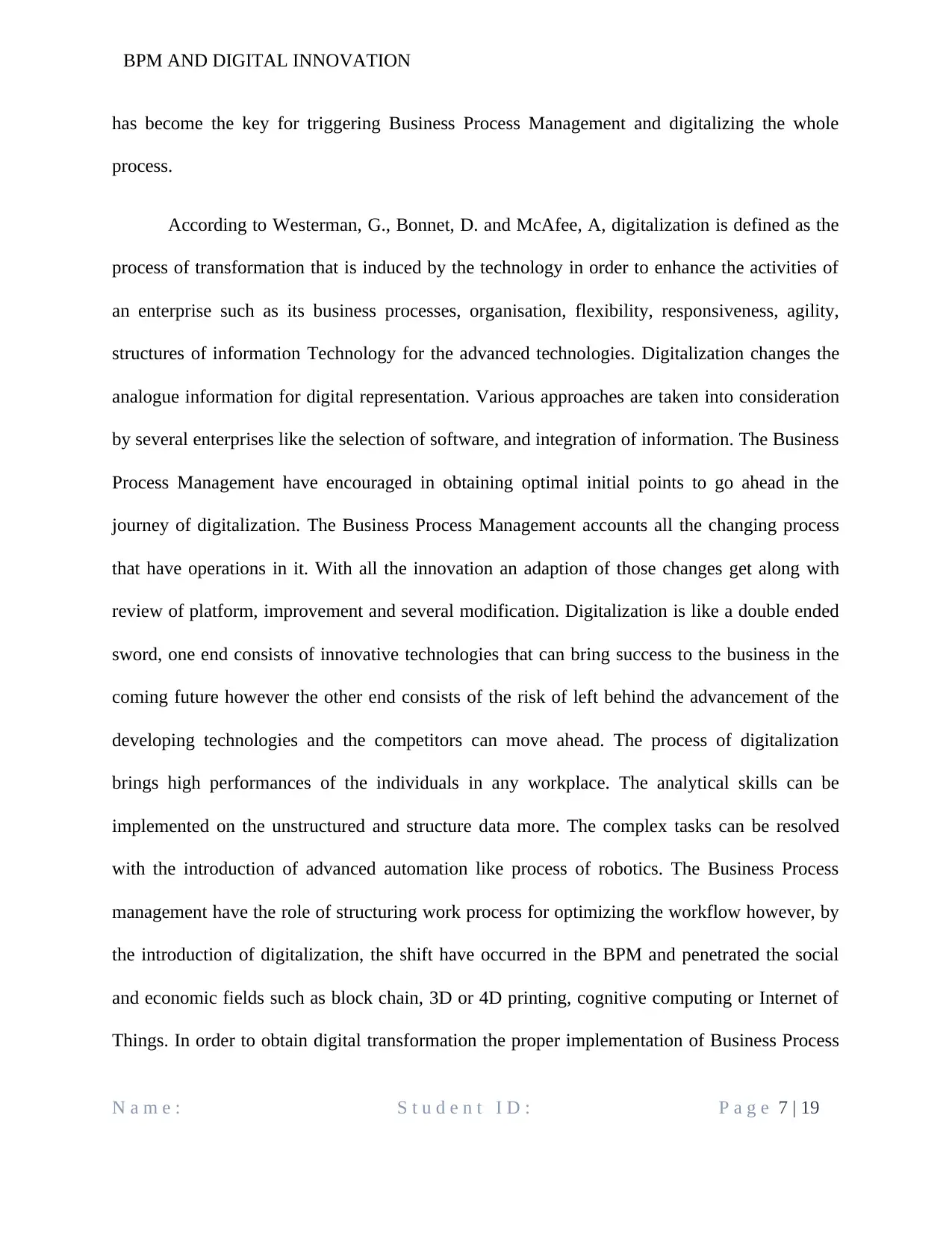
BPM AND DIGITAL INNOVATION
has become the key for triggering Business Process Management and digitalizing the whole
process.
According to Westerman, G., Bonnet, D. and McAfee, A, digitalization is defined as the
process of transformation that is induced by the technology in order to enhance the activities of
an enterprise such as its business processes, organisation, flexibility, responsiveness, agility,
structures of information Technology for the advanced technologies. Digitalization changes the
analogue information for digital representation. Various approaches are taken into consideration
by several enterprises like the selection of software, and integration of information. The Business
Process Management have encouraged in obtaining optimal initial points to go ahead in the
journey of digitalization. The Business Process Management accounts all the changing process
that have operations in it. With all the innovation an adaption of those changes get along with
review of platform, improvement and several modification. Digitalization is like a double ended
sword, one end consists of innovative technologies that can bring success to the business in the
coming future however the other end consists of the risk of left behind the advancement of the
developing technologies and the competitors can move ahead. The process of digitalization
brings high performances of the individuals in any workplace. The analytical skills can be
implemented on the unstructured and structure data more. The complex tasks can be resolved
with the introduction of advanced automation like process of robotics. The Business Process
management have the role of structuring work process for optimizing the workflow however, by
the introduction of digitalization, the shift have occurred in the BPM and penetrated the social
and economic fields such as block chain, 3D or 4D printing, cognitive computing or Internet of
Things. In order to obtain digital transformation the proper implementation of Business Process
N a m e : S t u d e n t I D : P a g e 7 | 19
has become the key for triggering Business Process Management and digitalizing the whole
process.
According to Westerman, G., Bonnet, D. and McAfee, A, digitalization is defined as the
process of transformation that is induced by the technology in order to enhance the activities of
an enterprise such as its business processes, organisation, flexibility, responsiveness, agility,
structures of information Technology for the advanced technologies. Digitalization changes the
analogue information for digital representation. Various approaches are taken into consideration
by several enterprises like the selection of software, and integration of information. The Business
Process Management have encouraged in obtaining optimal initial points to go ahead in the
journey of digitalization. The Business Process Management accounts all the changing process
that have operations in it. With all the innovation an adaption of those changes get along with
review of platform, improvement and several modification. Digitalization is like a double ended
sword, one end consists of innovative technologies that can bring success to the business in the
coming future however the other end consists of the risk of left behind the advancement of the
developing technologies and the competitors can move ahead. The process of digitalization
brings high performances of the individuals in any workplace. The analytical skills can be
implemented on the unstructured and structure data more. The complex tasks can be resolved
with the introduction of advanced automation like process of robotics. The Business Process
management have the role of structuring work process for optimizing the workflow however, by
the introduction of digitalization, the shift have occurred in the BPM and penetrated the social
and economic fields such as block chain, 3D or 4D printing, cognitive computing or Internet of
Things. In order to obtain digital transformation the proper implementation of Business Process
N a m e : S t u d e n t I D : P a g e 7 | 19
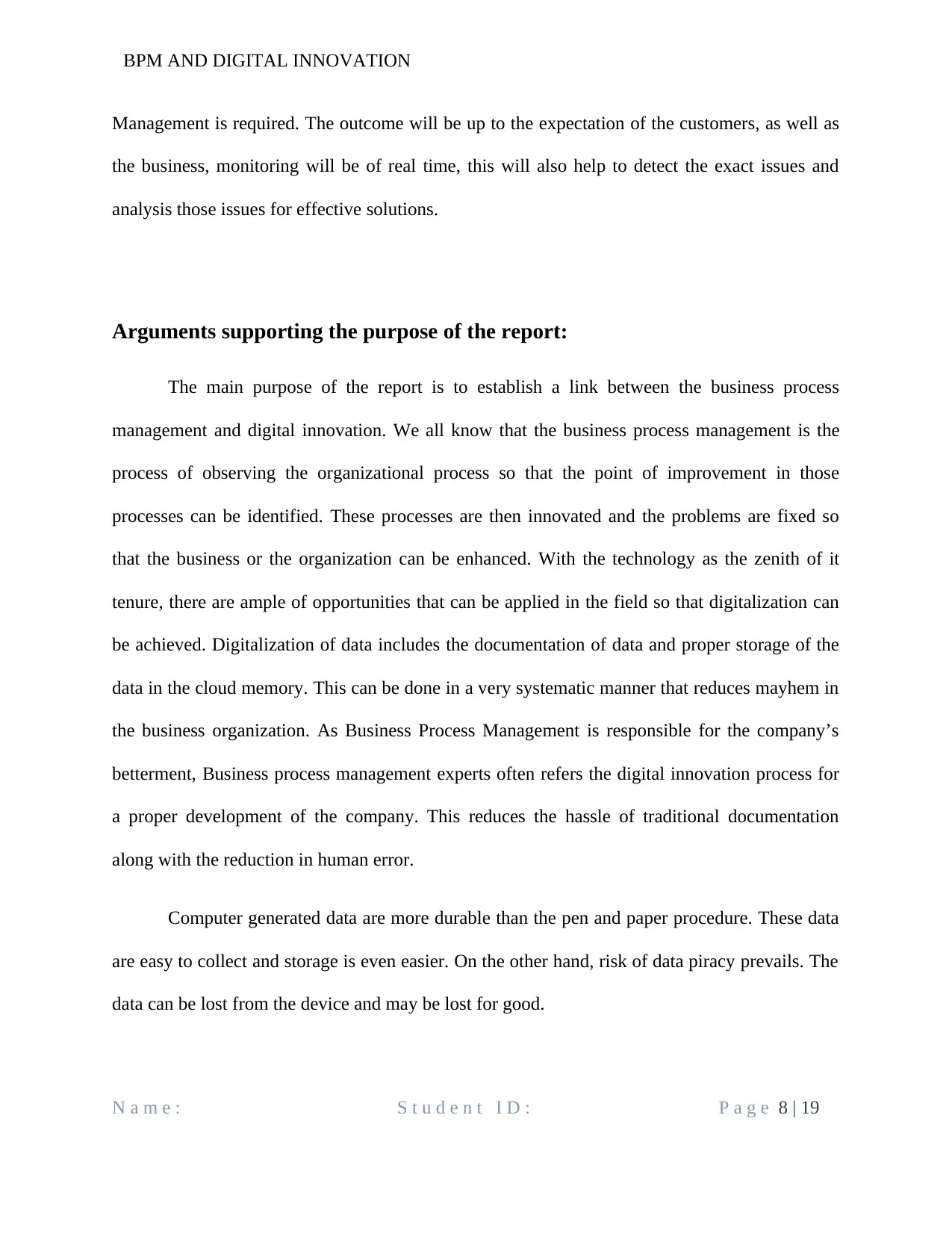
BPM AND DIGITAL INNOVATION
Management is required. The outcome will be up to the expectation of the customers, as well as
the business, monitoring will be of real time, this will also help to detect the exact issues and
analysis those issues for effective solutions.
Arguments supporting the purpose of the report:
The main purpose of the report is to establish a link between the business process
management and digital innovation. We all know that the business process management is the
process of observing the organizational process so that the point of improvement in those
processes can be identified. These processes are then innovated and the problems are fixed so
that the business or the organization can be enhanced. With the technology as the zenith of it
tenure, there are ample of opportunities that can be applied in the field so that digitalization can
be achieved. Digitalization of data includes the documentation of data and proper storage of the
data in the cloud memory. This can be done in a very systematic manner that reduces mayhem in
the business organization. As Business Process Management is responsible for the company’s
betterment, Business process management experts often refers the digital innovation process for
a proper development of the company. This reduces the hassle of traditional documentation
along with the reduction in human error.
Computer generated data are more durable than the pen and paper procedure. These data
are easy to collect and storage is even easier. On the other hand, risk of data piracy prevails. The
data can be lost from the device and may be lost for good.
N a m e : S t u d e n t I D : P a g e 8 | 19
Management is required. The outcome will be up to the expectation of the customers, as well as
the business, monitoring will be of real time, this will also help to detect the exact issues and
analysis those issues for effective solutions.
Arguments supporting the purpose of the report:
The main purpose of the report is to establish a link between the business process
management and digital innovation. We all know that the business process management is the
process of observing the organizational process so that the point of improvement in those
processes can be identified. These processes are then innovated and the problems are fixed so
that the business or the organization can be enhanced. With the technology as the zenith of it
tenure, there are ample of opportunities that can be applied in the field so that digitalization can
be achieved. Digitalization of data includes the documentation of data and proper storage of the
data in the cloud memory. This can be done in a very systematic manner that reduces mayhem in
the business organization. As Business Process Management is responsible for the company’s
betterment, Business process management experts often refers the digital innovation process for
a proper development of the company. This reduces the hassle of traditional documentation
along with the reduction in human error.
Computer generated data are more durable than the pen and paper procedure. These data
are easy to collect and storage is even easier. On the other hand, risk of data piracy prevails. The
data can be lost from the device and may be lost for good.
N a m e : S t u d e n t I D : P a g e 8 | 19
⊘ This is a preview!⊘
Do you want full access?
Subscribe today to unlock all pages.

Trusted by 1+ million students worldwide
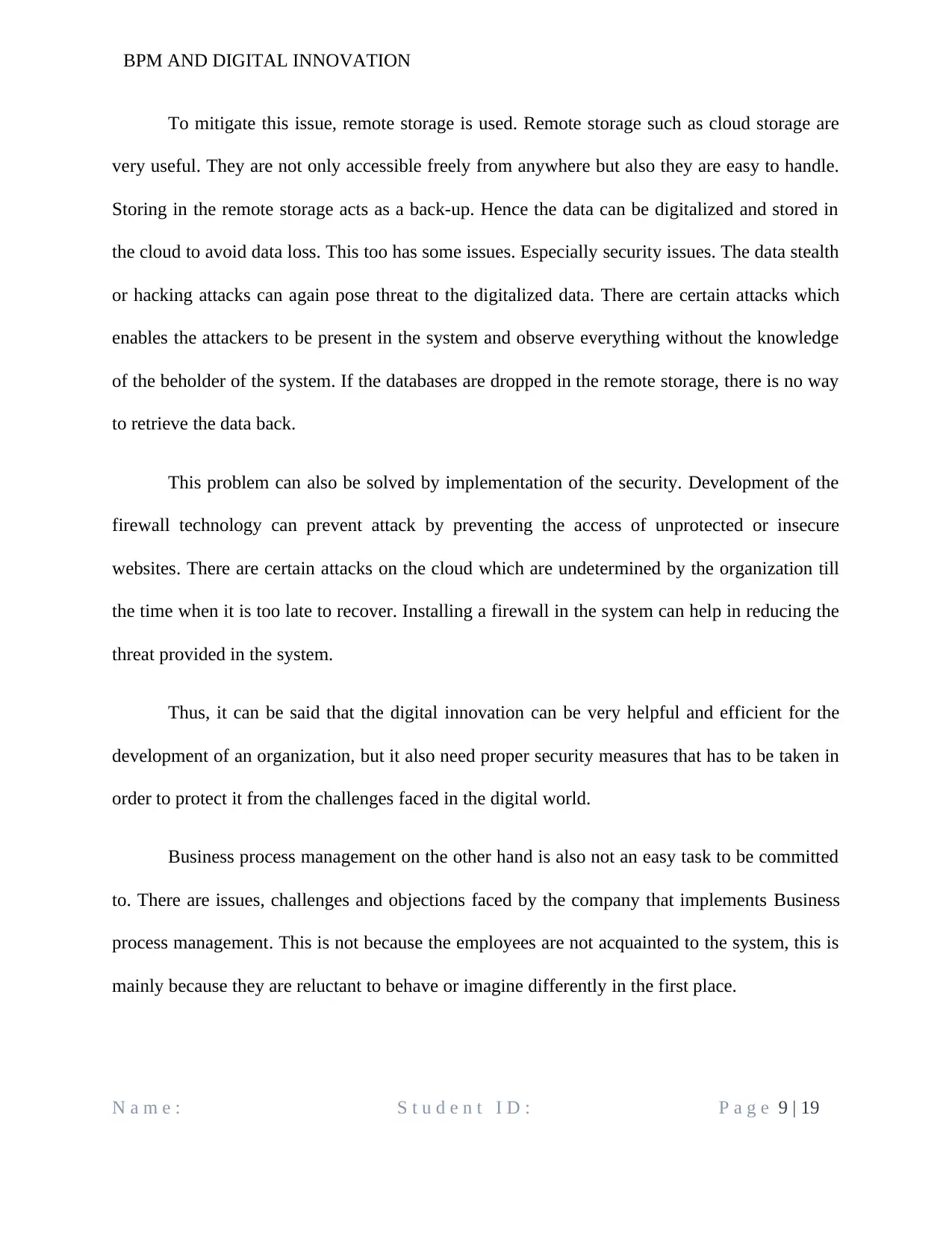
BPM AND DIGITAL INNOVATION
To mitigate this issue, remote storage is used. Remote storage such as cloud storage are
very useful. They are not only accessible freely from anywhere but also they are easy to handle.
Storing in the remote storage acts as a back-up. Hence the data can be digitalized and stored in
the cloud to avoid data loss. This too has some issues. Especially security issues. The data stealth
or hacking attacks can again pose threat to the digitalized data. There are certain attacks which
enables the attackers to be present in the system and observe everything without the knowledge
of the beholder of the system. If the databases are dropped in the remote storage, there is no way
to retrieve the data back.
This problem can also be solved by implementation of the security. Development of the
firewall technology can prevent attack by preventing the access of unprotected or insecure
websites. There are certain attacks on the cloud which are undetermined by the organization till
the time when it is too late to recover. Installing a firewall in the system can help in reducing the
threat provided in the system.
Thus, it can be said that the digital innovation can be very helpful and efficient for the
development of an organization, but it also need proper security measures that has to be taken in
order to protect it from the challenges faced in the digital world.
Business process management on the other hand is also not an easy task to be committed
to. There are issues, challenges and objections faced by the company that implements Business
process management. This is not because the employees are not acquainted to the system, this is
mainly because they are reluctant to behave or imagine differently in the first place.
N a m e : S t u d e n t I D : P a g e 9 | 19
To mitigate this issue, remote storage is used. Remote storage such as cloud storage are
very useful. They are not only accessible freely from anywhere but also they are easy to handle.
Storing in the remote storage acts as a back-up. Hence the data can be digitalized and stored in
the cloud to avoid data loss. This too has some issues. Especially security issues. The data stealth
or hacking attacks can again pose threat to the digitalized data. There are certain attacks which
enables the attackers to be present in the system and observe everything without the knowledge
of the beholder of the system. If the databases are dropped in the remote storage, there is no way
to retrieve the data back.
This problem can also be solved by implementation of the security. Development of the
firewall technology can prevent attack by preventing the access of unprotected or insecure
websites. There are certain attacks on the cloud which are undetermined by the organization till
the time when it is too late to recover. Installing a firewall in the system can help in reducing the
threat provided in the system.
Thus, it can be said that the digital innovation can be very helpful and efficient for the
development of an organization, but it also need proper security measures that has to be taken in
order to protect it from the challenges faced in the digital world.
Business process management on the other hand is also not an easy task to be committed
to. There are issues, challenges and objections faced by the company that implements Business
process management. This is not because the employees are not acquainted to the system, this is
mainly because they are reluctant to behave or imagine differently in the first place.
N a m e : S t u d e n t I D : P a g e 9 | 19
Paraphrase This Document
Need a fresh take? Get an instant paraphrase of this document with our AI Paraphraser
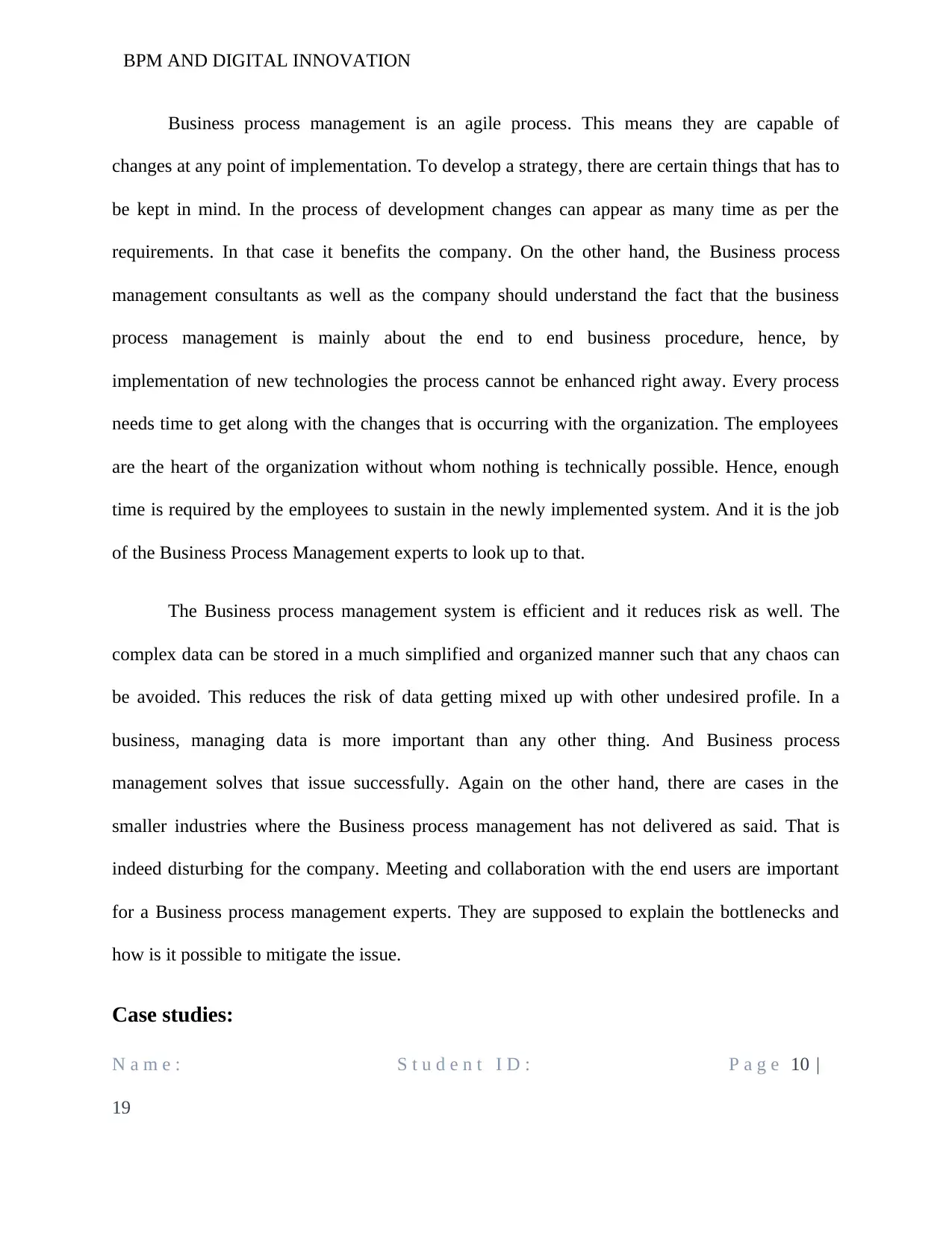
BPM AND DIGITAL INNOVATION
Business process management is an agile process. This means they are capable of
changes at any point of implementation. To develop a strategy, there are certain things that has to
be kept in mind. In the process of development changes can appear as many time as per the
requirements. In that case it benefits the company. On the other hand, the Business process
management consultants as well as the company should understand the fact that the business
process management is mainly about the end to end business procedure, hence, by
implementation of new technologies the process cannot be enhanced right away. Every process
needs time to get along with the changes that is occurring with the organization. The employees
are the heart of the organization without whom nothing is technically possible. Hence, enough
time is required by the employees to sustain in the newly implemented system. And it is the job
of the Business Process Management experts to look up to that.
The Business process management system is efficient and it reduces risk as well. The
complex data can be stored in a much simplified and organized manner such that any chaos can
be avoided. This reduces the risk of data getting mixed up with other undesired profile. In a
business, managing data is more important than any other thing. And Business process
management solves that issue successfully. Again on the other hand, there are cases in the
smaller industries where the Business process management has not delivered as said. That is
indeed disturbing for the company. Meeting and collaboration with the end users are important
for a Business process management experts. They are supposed to explain the bottlenecks and
how is it possible to mitigate the issue.
Case studies:
N a m e : S t u d e n t I D : P a g e 10 |
19
Business process management is an agile process. This means they are capable of
changes at any point of implementation. To develop a strategy, there are certain things that has to
be kept in mind. In the process of development changes can appear as many time as per the
requirements. In that case it benefits the company. On the other hand, the Business process
management consultants as well as the company should understand the fact that the business
process management is mainly about the end to end business procedure, hence, by
implementation of new technologies the process cannot be enhanced right away. Every process
needs time to get along with the changes that is occurring with the organization. The employees
are the heart of the organization without whom nothing is technically possible. Hence, enough
time is required by the employees to sustain in the newly implemented system. And it is the job
of the Business Process Management experts to look up to that.
The Business process management system is efficient and it reduces risk as well. The
complex data can be stored in a much simplified and organized manner such that any chaos can
be avoided. This reduces the risk of data getting mixed up with other undesired profile. In a
business, managing data is more important than any other thing. And Business process
management solves that issue successfully. Again on the other hand, there are cases in the
smaller industries where the Business process management has not delivered as said. That is
indeed disturbing for the company. Meeting and collaboration with the end users are important
for a Business process management experts. They are supposed to explain the bottlenecks and
how is it possible to mitigate the issue.
Case studies:
N a m e : S t u d e n t I D : P a g e 10 |
19
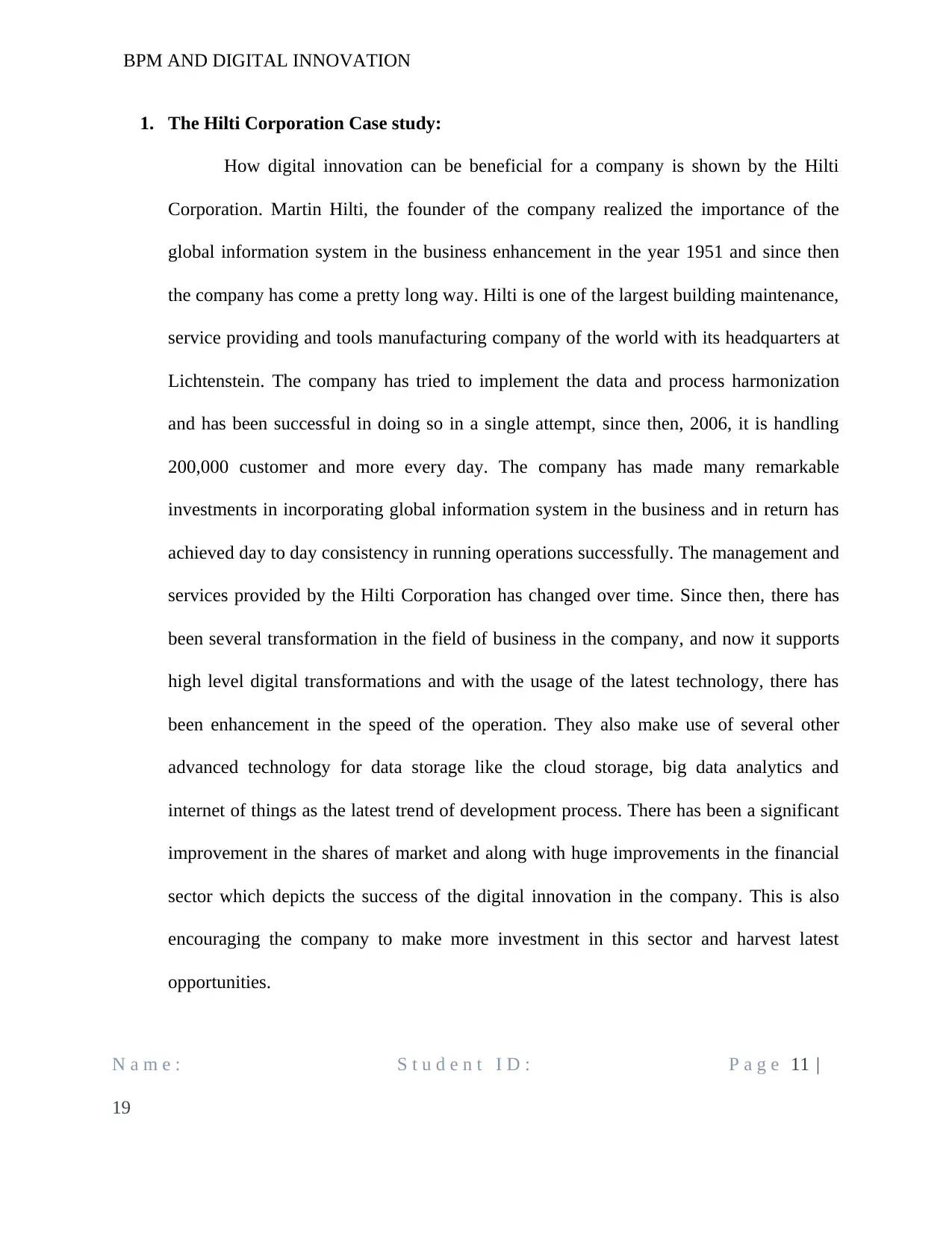
BPM AND DIGITAL INNOVATION
1. The Hilti Corporation Case study:
How digital innovation can be beneficial for a company is shown by the Hilti
Corporation. Martin Hilti, the founder of the company realized the importance of the
global information system in the business enhancement in the year 1951 and since then
the company has come a pretty long way. Hilti is one of the largest building maintenance,
service providing and tools manufacturing company of the world with its headquarters at
Lichtenstein. The company has tried to implement the data and process harmonization
and has been successful in doing so in a single attempt, since then, 2006, it is handling
200,000 customer and more every day. The company has made many remarkable
investments in incorporating global information system in the business and in return has
achieved day to day consistency in running operations successfully. The management and
services provided by the Hilti Corporation has changed over time. Since then, there has
been several transformation in the field of business in the company, and now it supports
high level digital transformations and with the usage of the latest technology, there has
been enhancement in the speed of the operation. They also make use of several other
advanced technology for data storage like the cloud storage, big data analytics and
internet of things as the latest trend of development process. There has been a significant
improvement in the shares of market and along with huge improvements in the financial
sector which depicts the success of the digital innovation in the company. This is also
encouraging the company to make more investment in this sector and harvest latest
opportunities.
N a m e : S t u d e n t I D : P a g e 11 |
19
1. The Hilti Corporation Case study:
How digital innovation can be beneficial for a company is shown by the Hilti
Corporation. Martin Hilti, the founder of the company realized the importance of the
global information system in the business enhancement in the year 1951 and since then
the company has come a pretty long way. Hilti is one of the largest building maintenance,
service providing and tools manufacturing company of the world with its headquarters at
Lichtenstein. The company has tried to implement the data and process harmonization
and has been successful in doing so in a single attempt, since then, 2006, it is handling
200,000 customer and more every day. The company has made many remarkable
investments in incorporating global information system in the business and in return has
achieved day to day consistency in running operations successfully. The management and
services provided by the Hilti Corporation has changed over time. Since then, there has
been several transformation in the field of business in the company, and now it supports
high level digital transformations and with the usage of the latest technology, there has
been enhancement in the speed of the operation. They also make use of several other
advanced technology for data storage like the cloud storage, big data analytics and
internet of things as the latest trend of development process. There has been a significant
improvement in the shares of market and along with huge improvements in the financial
sector which depicts the success of the digital innovation in the company. This is also
encouraging the company to make more investment in this sector and harvest latest
opportunities.
N a m e : S t u d e n t I D : P a g e 11 |
19
⊘ This is a preview!⊘
Do you want full access?
Subscribe today to unlock all pages.

Trusted by 1+ million students worldwide
1 out of 19
Related Documents
Your All-in-One AI-Powered Toolkit for Academic Success.
+13062052269
info@desklib.com
Available 24*7 on WhatsApp / Email
![[object Object]](/_next/static/media/star-bottom.7253800d.svg)
Unlock your academic potential
Copyright © 2020–2025 A2Z Services. All Rights Reserved. Developed and managed by ZUCOL.





